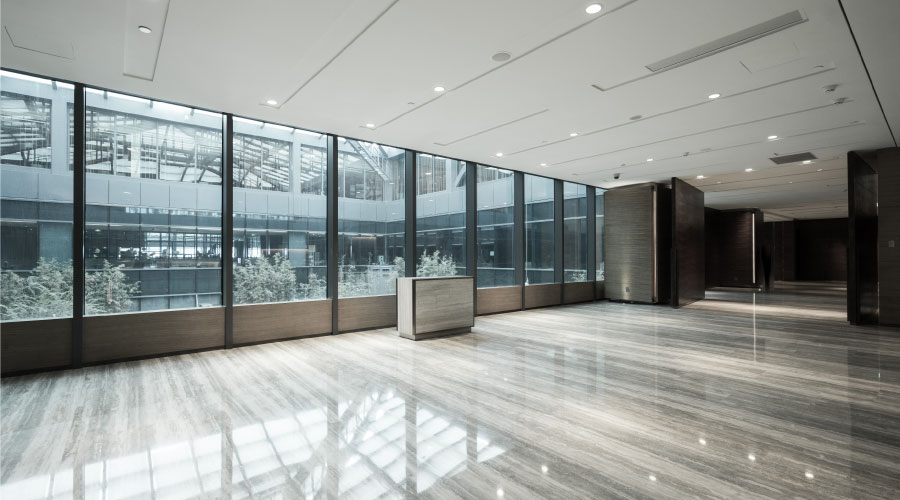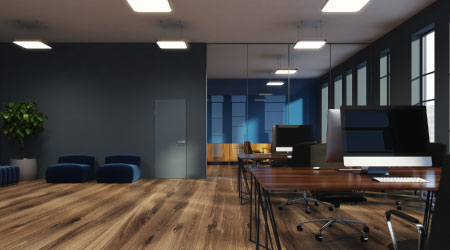Enhancing the Life and Look of Flooring
Understanding existing and emerging options, as well as making plans for
post-installation care, can improve flooring performance and appearance
The choice of flooring for particular areas of an institutional or commercial facility can go a long way in shaping that facility’s image. Among the most important issues in flooring specification is post-installation maintenance because flooring that cannot be maintained properly can quickly become an eyesore and require replacement.
A review of the most common types of flooring available today, along with an update of the newest flooring options, will help managers develop a more successful post-installation maintenance program that protect’s the organization’s investment.
Common Flooring Types
Carpet. In many institutional and commercial facilities today, carpet is replacing resilient flooring, largely because it has aesthetic appeal, reduces noise and is easy to maintain.
Concrete. Concrete remains a durable standard for high-traffic areas and heavy loads. Float, trowel and exposed-aggregate finishes offer architectural variety, while many other textures and colors are available.
Resilient flooring. Resilient flooring is a widely used interior floor covering that wears well, reduces dust, and fits any décor. Available in tiles and sheets, it comes in a range of materials, including cork, linoleum, rubber, vinyl, and vinyl composition.
Stone. Generically, stone refers to somewhat porous materials, including as granite, marble, slate and travertine. Granite and marble are particularly hard and durable, while also presenting an appealing aesthetic finish. Stone has both exterior and interior applications.
Tile. Tile is available in uniform 12-by-12- or 16-by-16 inch shapes, or various geometric or odd-shaped patterns, ceramic and porcelain. Tile also is available in matte, semi-gloss or high-gloss finishes depending on the application.
Wood. Wood has been the flooring of choice since before the industrial revolution, and it still has wide interior and even exterior applications. It offers beauty, durability and resilience.
Newest Flooring Options
The trend that most delights designers is the explosion of composites. Rather than being limited by natural products, composites combine the best of several materials: surface hardness for wear, dent and chip resistance; acoustical properties for sound absorption; lamination with foam for cushioning; dimensional stability; and moisture resistance. So facilities get a floor that looks like wood and wears like iron, yet is resilient with a high acoustic absorption rate.
Woven vinyl sisal carpet has garnered awards from the industry for its performance in high-traffic areas. It is easy to install, does not fray when cut, and comes in dozens of textures and colors. Installers can create borders, inlays and seams for customized looks.
Acoustic vinyl offers special sound-reduction qualities. And its anti-fatigue properties result from a construction that uses two layers of closed-cell, expanded vinyl foam.
Other popular resilient products include commercial grade no-wax vinyl hardwoods. In commercial rubber and vinyl flooring, a new solid vinyl tile offers added slip resistance. Also, some rubber and vinyl brands use materials and methods that are more environmentally friendly.
Managers also can specify rubber-based wall bases that fit snugly against the tops of walls, have molded corner blocks, and are accurately mitered for a perfect fit. These products resist scratching and abrasion, and they eliminate nailing, filling, sanding and finishing associated with wood bases.
Wood and laminate choices also have expanded dramatically. Wood’s rich, natural look has made it a favorite of designers and architects. But maintenance is not as attractive a feature. Improvements in hardwood construction and introduction of a variety of coatings and laminates have changed the situation for the better.
Excellent water- and oil-based polyurethane finishes give natural wood floors the impact, wear and scratch resistance of laminates. The latest generation of water-based polyurethane finishes for heavy-traffic areas performs better than other types. They also are fast drying — generally in two-three hours — and fast-curing — 75 percent after one day, 90 percent after three days, fully cured in seven days.
These finishes are non-flammable, and they offer levels of volatile organic chemicals that are less than 350 grams per liter. The recommended application of these finishes calls for sanding and polishing, then applying a sealer — which could be a stain — and two coats of polyurethane.
Choices Expand
While oak, maple and birch have been the hardwood staples, now facilities more often feature exotic woods, such as bamboo, an environmentally friendly choice, as well as cork, which is made from the bark of certain oak trees. Cork is now available in many light and contemporary colors.
Laminates offer the natural wood look under a chip- and dent-resistant surface and layered construction for resilience. Wood laminates don’t require refinishing or re-waxing, as wood does.
For commercial applications, manufacturers recommend high-pressure laminates for better chip and impact resistance. Some laminates have high stability and can be installed right over concrete that contains high levels of moisture. They also have a wear layer on top, such as melamine or aluminum oxide.
Designers can choose from traditional maple, oak and birch looks, exotic wood looks, and an array of printed visuals. Cork- laminate-plank products use a cork surface over layers of wood or particleboard.
Finally, a trend that is gaining momentum is creating a green or sustainable environment that incorporates flooring considerations. For example, using alternate types of flooring that offer greater protection from ultraviolet light in interior products is on the rise, as more natural light and less fluorescent lighting are included in facility designs.
Beyond Installation
Specification of flooring also should take into account issues that managers and front-line workers will face once the flooring is in place.
For example, floor-care methods for daily flooring maintenance are incorporating more mechanical help for front-line custodians in the form of vacuuming equipment. While dry mopping can simply re-distribute dust into the air, vacuuming, especially with HEPA-filtered vacuums, can remove more of the dust and dirt from the environment.
Managers also need to consider protection of installed flooring. For example, natural concrete offers a very high compressive strength, but it is subject to staining, dusting, spalling and moisture absorption if not properly sealed.
After pouring, concrete must cure for 30 days before gaining full strength, so sealing should not be done before then. Workers should apply the sealer and an epoxy paint to harden and seal the surface so it will support heavy traffic with minimum maintenance required in the future.
Since concrete is often used in garages and other storage areas, workers should not apply latex floor paints where they will come into contact with rubber tires. Also, some alkyds won’t withstand the heat from hot tires. Also, workers should check the grease and oil resistance of the paint.
The issue of repairing concrete flooring also is important. The durability of a concrete patch depends greatly on surface preparation. The old concrete surface is the weak link. Tests have shown that 4,000-psi concrete has a clean-surface tensile strength of only 75 psi; sandblasting increases the surface strength to 275 psi.
Where disintegration of old concrete has exposed the reinforcing steel, the steel will corrode. In this case, the steel must be exposed all around and the corrosion removed, and the patch must encapsulate the exposed reinforcing steel to prevent premature patch failure.
As with all flooring types, resilient flooring care starts with keeping the floor clean by regular mopping and vacuuming. A damp mop and warm water will usually remove stains, and a solvent-based floor polish can bring back the shine when vinyl flooring dulls after washing.
Natural stone has the look designers want, along with durability and low maintenance. While stone products appear dense and impermeable, all stone materials, even marble and granite, are somewhat porous. They will easily absorb stains and moisture if left unsealed.
The best way to maintain natural stone flooring is to regularly vacuum it, clean it with a stone cleaner, and use an impregnator/sealer/finisher. Acrylic polymer blends provide these surfaces protection against stains and protect the surface from scratches. Workers must reapply the sealer typically every year because, as the surface is worn, the sealer material also wears off. Even in lower-traffic areas, sealers tend to evaporate over time.
Tile manufacturers are getting better at producing ceramic tile that looks like natural stone. As tile use expands due to its low maintenance requirements, more cleaning products become available. Crews should not use abrasive powders or cleaning solutions on tiles. Instead, they can use degreasers to remove stains and all-purpose cleaners for everyday cleaning. For high- gloss tile, workers can use a cleaner that dries film-free to return the original gloss.
While untreated wood products require refinishing and waxing periodically, laminates do not. They can be maintained in as good condition in ten years as the day they were installed with regular vacuuming and less frequent damp mopping.
Wood flooring benefits greatly from polyurethane surface protection. It doesn’t require waxing and is very impact, wear and scratch resistant. Wet-cleaning with a cleaner will bring out the beauty of natural wood and protect the surface coating. If the wood is not coated, it requires waxing, with periodic striping and re-waxing as wax builds up and dulls the finish.
Complete resurfacing — including cleaning, polishing and finishing — requires an orbital sander, drum sander, edger, and polisher. While both water- and oil-based finishes are available, oil-based finishers are best for returning the various shades of the wood to the original condition.
Using new, advanced floor-care products as part of scheduled floor maintenance will enhance the facilities' image while extending the life of flooring at a reasonable cost.
More for the Floor
Managers seeking more information on flooring issues can check out these organizations:
- The Carpet and Rug Institute, 310 Holiday Ave., Dalton, GA 30720. (800) 882-8846.
- International Wood Products Association, 4214 King St. W., Alexandria, VA 22302. (703) 820-6696.
- National Tile Contractors Association, 626 Lakeland East Drive, Jackson, MS 39232. (601) 939-2071
- Resilient Floor Covering Institute, 401 E. Jefferson St., Rockville, MD 20850. (301) 340-8580.
- Tile Contractors Association of America, (800) 655-8453.
|
Related Topics:











